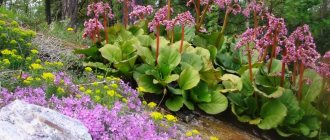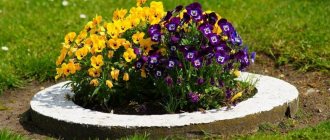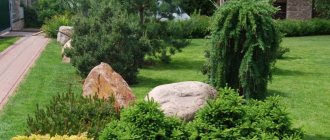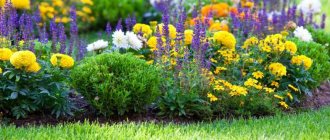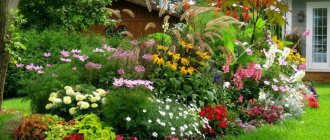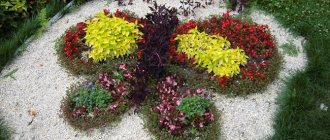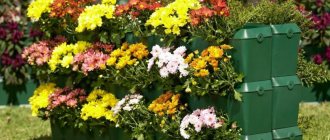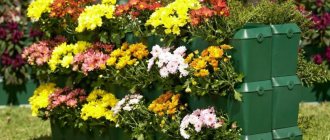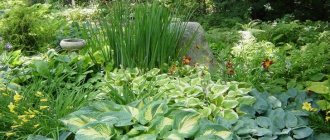Owners of country houses and summer cottages have long ceased to prioritize the cultivation of agricultural crops. Many modern areas are decorated with all kinds of ornamental plants. Almost all landscape projects include perennial beds. An ideal flower garden continues to delight those around you with the beauty of its leaves and buds throughout the season. Continuous flowering can be achieved by strictly observing planting rules, soil requirements for each plant, and the correct selection of varieties.
Peculiarities
A bright, dense flower bed will only be possible in a lighted area. To correctly create a composition, you need to select plants in advance and imagine the appearance of each specimen at different times of the year. Transforming a garden is a labor-intensive process that requires constant presence in the garden beds. Before you start working with soil, you should consider the following nuances:
- Soil features. Each flower has its own type of soil;
- Climate. Emphasis should be placed on pure varieties and hybrids that take root well in the planting region;
- Terrain. You can make a beautiful flower bed on a flat surface, on a slope, or in a lowland. A certain type of plant is suitable for each option;
- Illumination. Not all colors are suitable for a sunny area. Species that love partial shade are best planted in a flowerbed near the fence, next to tall bushes;
- Planting density. It is necessary to maintain a certain distance for each plant in the circle of neighboring flowers;
- Flowering dates. In order for the flowerbed to delight with color throughout the summer season, varieties should be selected with different flowering periods and durations.
Borders and ribbon flower beds
The easiest type of flower bed to identify, which is a narrow strip of densely planted plants forming a continuous lush ribbon, is, of course, a border. A decorative frame or edging for paths, flower beds, lawns, clearings, and other decorative objects plays the role of a beautiful and lush frame and an elegant line laid along the border of the object, hiding or emphasizing the transition. Borders can be flowering, temporary, trimmed, or landscape. They are created from shrubs and herbaceous perennials, biennials and even annuals. The border can be bright or neutral, more or less high. Plants are always chosen in accordance with the style of the garden and taking into account the goal of achieving maximum line density.
Ribbon flower beds, mixed borders, complex borders or just ribbons are variations of the border, but created according to the principle of a classic flower bed, a narrow flower bed up to 1 m wide and of any length. This is a combination of at least 3 types of plants that differ in their decorative characteristics; it is a very elongated flower bed with a constantly repeating pattern and serves as a border. The main task of ribbon flower beds is to mask unsightly, residual narrow strips of soil that are not suitable for classical compositions, decorate boring walls or fences, hide functional communications, and create the effect of lush landscaping in a minimal area. It is ribbon flower beds that are placed under hedges and along the walls of a house or garage.
Flower bed border along the garden path
Types of flower beds
The size of the flower bed can be very diverse. The choice depends on the area of the site and the availability of free space. Flowerbeds with perennials are classified as follows:
- Modular. The plants in the flower garden are separated by tiles and various architectural products;
- Mixborders. Place under windows, along paths. The compositions consist of a variety of colors;
- Solitaires. Flower beds contain plants that are similar in some way (color, shape of petals, size, height of stems);
- Discounts. Elongated planting of monochromatic plants. Often they represent a certain ornament and are part of a large flower bed;
- Curbs. Short strips of low plants. They are used to highlight certain areas of the flower garden;
- Rockeries. The plants in the flowerbed are complemented by decor made of stones; the popular name is stone gardens;
- Rock gardens. Flowers grow on a hill in several tiers.
Beautiful combination of flowers in a flower bed
You can, of course, randomly plant plants in a flower garden, regardless of the color of their flowers. Such a motley picture will perhaps be more reminiscent of a natural landscape. But this is unlikely to be the best option, unless, of course, you are creating something like a rock garden.
It is more logical to plant plants in the flower garden that match well in color, as well as in the original shape of the leaves. This allows you to create successful compositions.
Here is an example of a successful combination of some plants in a flower garden:
- phlox and lilies;
- phlox and rudbeckia;
- echinacea and sedum;
- phlox splayed and subulate;
- phlox subulate and iris;
- peony and lupine;
- peony and catnip;
- bluebell and foxglove;
- dicentra and corydalis;
- hakonechloa and hoofweed;
- astrantia and filipendula.
As an example of creating a flower garden at your dacha with your own hands, I suggest you watch this video.
Flowerbed shape and size
The size of the flower bed, as well as its decorative contents, is chosen based on personal preferences. In order not to spoil the overall appearance of the site and not to destroy living plants, some design factors should be taken into account. It is necessary to provide for free space on the estate, the number, and location of buildings.
They also pay attention to the location of the house. If it is located in the center of the yard, all its windows overlook personal territory, it would be logical to make a beautiful flowering flowerbed of any fancy shape in front of them. Paths and driveways are decorated with narrow flower beds of small, climbing plants.
Flower beds of regular geometric shape look better on a flat, well-groomed lawn. You can emphasize the boundaries of round, square, rectangular flower beds with the help of fences and low fences. Arched, abstract planting is carried out in the form of combinations of several varieties and groups of plants. For example, large spherical bushes surrounded by several rings of bright flowers.
Before selecting plants, even for the simplest flower garden, it is necessary to develop a detailed diagram.
Types of flower beds: ways to expand the area of flower beds
Essentially, a flower garden is an area in which ornamental plants are grown, a general term for any ensemble of ornamental plants. Flower beds can be different in both content and shape. But any composition made up of ornamental plants in a limited, delineated, separated area is a flower garden. Therefore, ridges, borders, and flower beds can also be safely called flower beds.
Beautiful, bright and lush flower beds set the character and style of the garden. And sometimes, admiring flower ensembles, you really want there to be even more colors in the garden! When there is a desire to increase the area of flower beds and edgings, to expand flowering objects, finding a way to implement this idea often leads to some difficulties. Usually flower beds are expanded at the expense of lawns. And this can be done in several ways. In this article we will look at the main types of flower beds and ways to expand their area.
Flower garden at the dacha
Flowerbed design
You won’t surprise anyone with simple flower beds. Plants are planted not only in open ground, but also in various objects raised above the ground. They are often made in the same style as a terrace, veranda, swimming pool, or the nearest building. In just a couple of hours, any item that has been collecting dust in the barn can turn into an original landscape design object. The following types of flower beds can decorate your garden:
- Regular. Plants are arranged symmetrically, tightly, in even blocks. Flowers must have one flowering period and height. Hybrids are more suitable for this purpose;
- Irregular. A free-form flower garden with perennials that bloom alternately throughout the season;
- Carpet. The close arrangement of low-growing plants creates a carpet effect. Various inert materials (pebbles, sand) will help create a clear pattern. The most popular design example is the flower clock;
- Elated. A non-standard flower garden is raised above the ground by 20-100 cm. It can be in one or several tiers. A combination of ground cover and tall plants is possible;
- Vertical. Used to save space. Place it on the ground, hang it, attach it to any surface. The main advantage of this design is that there is no need for weeding;
- Multidimensional. The unusual flower garden is located not on a plane, but in volume. To create compositions, auxiliary structures are used. For example, a flowerbed made from an inverted umbrella, on a chair, in a cart;
- Ring. They are located in a ring around an object (tree, bush, large stone). To prolong the bright color, plants alternate according to the flowering period;
- Ostrovnaya. Includes plants of varying heights. The tallest perennials are in the center, low-growing along the edges;
- Flowerbed-panel. A complex flower garden resembles a carpet bed and reflects a specific image or inscription;
- Modular. In one space, flower beds unite individual areas with one concept. They are separated by slabs and paved paths.
Types of flower beds and rabatak
Today there are so many variations of decorative compositions and varieties of garden ensembles that even an experienced gardener finds it difficult not to get confused about the terms and their meaning. The frames between flower beds and ridges, islands and groups are erased. But the design of a garden is always based on basic principles and simple elements, thanks to which the effect of special expressiveness is created. And the main types of flower beds are no exception. After all, even the most complex projects still start from basic principles.
Flower garden
Flower beds are large, medium and small, strict and classic, natural and carpet, ornamental, ceremonial, seasonal, permanent and annual. They are made only from herbaceous perennials, annuals and biennials, or also from shrubs and trees, conifers and ferns, and sometimes even from lawns and decorative coverings, using not only plants to decorate and fill the territory of the site. Sometimes flower beds are so different in character that they seem to be completely separate, unrelated types of garden ensembles. But all decorative compositions, even if they differ from their counterparts, are considered flower beds.
To make it easier to choose design variations, there are basic types of flower beds - objects that differ in their shape, character, plants used and role in the design of a garden or summer cottage.
The basic varieties of flower beds include several types of decorative compositions, which are quite easy to recognize and distinguish:
Basic rules and recommendations for creating flower beds
When organizing a flower garden with your own hands, you should adhere to certain rules so as not to end up with a chaotic planting. Creating flower arrangements is a real art. You can avoid common mistakes if you listen to the recommendations of landscape designers.
Choosing a planting site and soil
The choice of location is influenced by the size and shape of the flower bed. It should be clearly visible and not interfere with passage, passage, or walking of animals. The best place is the front part of the garden, the entrance to the courtyard. Flower beds near the terrace and pool look great. In a well-lit area, even the most primitive plantings will look impressive.
All plants in a flower garden should have the same soil requirements. Fertile soil will be successful for all specimens. It must be fed with mineral and organic fertilizers. Perennials do not require replanting and careful care compared to annuals.
Plants that are well adapted to the region of planting will quickly take root.
Drawing up a plan and color scheme of plants
Planning a flower bed begins with drawing a diagram. First of all, we decide on the design. On paper, you need to indicate the planting zones, the expected number of plants, and their type. If necessary, the location, design features and size of decorative elements should be taken into account.
You can combine a variety of colors in a flowerbed. It is better not to make it too contrasting, with sharp transitions. Monochrome flower beds look beautiful - pink in summer, yellow in autumn. Combinations of two adjacent shades look advantageous - blue and purple, red and orange. Multi-colored mixborders are planted according to special patterns, with a choice of dominant and complementary tones.
Correct height distribution
When creating a composition, the height of the stems and bushiness are of great importance. The longest perennials are placed in the center or in the background if they will not create a shadow for the rest of the plantings. For edging, low-growing flowers (up to 20 cm) are used. There is room in the middle for those of average height.
The center can also be occupied by dwarf trees and low-growing coniferous shrubs. Their height should not exceed a third of the diameter of the flower bed. For flowers of the same height, a flowerbed in the shape of a flat pyramid is suitable. Bulbous plants that bloom early are best planted in the center so that their fading flowers are hidden behind the greenery of perennials.
Seasonality/flowering time
Plants for a flower bed are chosen depending on the expected effect. For simple flower beds, it is better if they are varieties with the same flowering period. In this case, the carefully thought-out pattern will not be disrupted. For constant color the range of species must be very large. The integrity of the composition can be achieved by planting flowers in groups, regardless of the size of the buds.
In a small flowerbed, it is better to place plants that smoothly change colors and decorate the area in a certain season. When grouping, you should take into account the growth rate and the size of each finished specimen. Species that grow too quickly will have to be contained.
What plants can be planted in a flower garden?
In early spring, small bulbous plants begin to bloom. This group of plants for a perennial flower garden includes: daffodils, chionodoxes, muscari, poultry plants, crocuses. They do not need to be dug up annually for storage, like tulips or gladioli.
The bulbs are planted at a distance of 10 cm from each other in large quantities. This is necessary in order to form a beautiful island of identical flowers, since most small-bulbous plants are short-growing (up to 20 cm). Their leaves are narrow and long, and their decorative effect is achieved solely through inflorescences, like those of muscari or hyacinth. Single specimens of such colors will be inconspicuous.
A little later, the familiar daisies and primroses, violets and dream grass begin to bloom. These are also quite small and inconspicuous individual primroses. To create a flower garden of continuous flowering, you will need a lot of planting material of primroses of any kind. But the decorativeness of the island of land that has barely appeared from under the snow is worth the expense of money and labor.
Flowers for summer and autumn
Perennials that bloom in warm weather are rich in both color and number of species. Beginning in May, peonies and irises bloom in a variety of colors. Later they are joined by daylilies and garden lilies, creating bright splashes of yellow, orange and red. Astilbe panicles harmoniously resonate with tall cereals: pampas grass, reed grass, pike grass. By placing tall candles of delphiniums in the background of the composition, you can support them with lupines of different heights and colors in the middle and foreground.
Ground cover plants like periwinkle, thyme, tenacious and others are also blooming. Despite the inconspicuousness of individual flowers, their clusters among grasses create picturesque spots of different colors. You can also supplement the compositions with wild herbs - yarrow and tansy with large inflorescences, jasmine, green grass, sage. These herbs are able to bloom throughout the season, filling the gaps between individual varieties and types of garden flowers.
At the end of summer, more and more yellow shades appear: rudbeckias, herbaceous sunflowers, yellow lilies and chrysanthemums. These colors can be harmoniously diluted by selecting varieties of red chrysanthemums and late dark pink phlox. The violet-blue range of September flowers and cushion asters will help to form flower beds in appropriate shades. By removing old flower stalks on astilbes and delphiniums, you can force these plants to bloom again.
Careful care of a perennial flower garden will help you enjoy the changing seasons and colors for several years in a row without annual work. Planted once, ornamental shrubs and flowers will delight the owners for a long time.
Popular perennials for flower beds
Every experienced gardener has a list of their favorite plants. Generally, preference is given to highly decorative flowers that do not require special care. The following types are an effective decoration for a summer cottage in the summer and spring seasons:
- Astilbe. A shade-tolerant plant with feathery, toothed leaves. Sometimes simple forms are found. Flowers form fluffy panicles of different colors and sizes.
- Helenium. Tall perennial with bright orange buds. Blooms profusely and for a long time, from mid-summer to the first frost;
- Geranium is magnificent. Grows as a spherical bush in partial shade. The leaves remain attractive green all season, turning purple in the fall. Blooms in late spring;
- Catnip. The herbaceous plant does not require special conditions and forms lush bushes up to 1 meter high. All its parts have a pleasant aroma. Blooms profusely and for a long time in the sun.
- Oriental poppy. With its beauty it can outshine almost all its neighbors in the flowerbed. Large red, pink, flesh-colored buds on meter-long stems bloom in early summer.
- Cuff. Decorates the garden from early spring until late autumn. It is famous for its unusual leaf shape and ability to guttation. Some species stand out for their abundant flowering, others for the color of their foliage and stem.
- Sedum. The perennial is varied in texture and color. Fits perfectly into any plant composition. Inflorescences up to 15 cm in diameter, stems up to 80 cm high;
- Rudbeckia. Long stems with yellow flowers can be seen from afar. Blooms in summer and autumn. Inflorescences can be one-color or two-color;
- Yarrow. Low-growing varieties are planted in a rocky garden, species with a long stem in the background of mixborders. Inflorescences in the form of baskets of different shades decorate flower beds from June to October;
- Hosta. The problem-free plant gets along well in the flower garden with all its neighbors. Does not like sun and strong wind. Large leaves have decorative value;
- Sage. The fragrant, diverse perennial has many species. It mainly blooms purple, but there are yellow and red inflorescences;
- Japanese anemone. Most varieties of this beautiful plant bloom in the spring, some twice a season. There may be solitary buds or collected in inflorescences.
Modular flower beds and series of flower beds
A modular flower garden is a rarity in small and medium-sized gardens. These are luxurious compositions that require the allocation of a large area for “solid” filling. In fact, a modular flower garden is a mosaic flower garden, which is a plot divided into separate repeating module sections, each of which is filled with a separate plant. Planting in sections allows you to create an overall variegated canvas. Modular flower beds are used for low, lush annuals and bulbous stars, seasonal plants that produce the brightest “spots.” Most often, the territory of a flower garden is divided into square modules with an area of about a square meter.
A series of flower beds is a decorative ensemble on a fairly large area, divided into mini-flower beds with paths between them that are different in shape, but create an overall picture. Today, the classic series of flower beds surrounded by boxwood are replacing other options, represented by small, strict flower beds with a different type of fencing - a border made of wicker, decorative fences, herbaceous plants. Representing the same complex figure, divided into small sections, a series of flower beds do not make the same strict impression, are more colorful and much easier to care for. Labyrinths also belong to the series of flower beds.
Modular flower beds
Recommended planting patterns
Beginner gardeners are better off practicing in a small area with good lighting. It is important not only to choose the right varieties, but also to correctly distribute the plants in the flower garden. In this case, it is necessary to take into account the size of the buds, inflorescences, the shape of the petals and leaves, the height of the stems and bushiness. In order for the composition to look as natural as possible, it is necessary to strictly follow the layout when planting according to the chosen scheme.
Simple planting scheme
To create the composition, unpretentious, hardy perennials are used. The flowerbed can be round, square, triangular. The following plants are used:
- The first planted in the center is paniculate phlox, purple and pink. You can do this in the fall or spring. Blooms all summer and September.
- Pink astilbe is planted in front of it. It begins to bloom a little earlier than phlox and ends in August;
- The daylily is placed on the same line with the astilbe. Planting is carried out in spring in well-drained soil.
- Heuchera is used for edging. Its silvery leaves will highlight a flower garden at any time of the year. Blooms in May, earlier than all collected species;
- You can make accents with the help of magnificent geranium bushes. Light flowers appear in mid-summer and remain until the end of the season.
Flowerbed of plants blooming in the first year
- The tallest hollyhock roses are planted in the background. You can use one variety or plant single plants of several colors. They will bloom in mid-summer;
- At the same level, the place is prepared for sunflowers. It grows quickly, so you should provide more space for it. Blooms in August until cold weather;
- Spanish poppy will be an excellent addition to a long-flowering flower bed. The first buds appear in May;
- St. John's wort is placed on the midline. It will catch the blooms of early species in June;
- For lobelia cardinalis, make room in the center. Thanks to the original leaves and bright flowering, it always remains attractive;
- The first lavender catnip flowers appear in May;
- The lower level is planted with bells. Already in June they will create a dense blue carpet;
- The beautiful blue baskets of Catananche “Blue Cupid” can be admired all summer long;
- The blue color of the lower part of the flowerbed dilutes the perennial gravel;
- The largest inflorescences of the sedum “Matrona” linger in the flowerbed the longest;
- Unusual leaves and flowers of Heuchera "Miracle" - a spectacular decor for a flower garden in the middle of summer.
Flowerbed in shades of pink and red
- Variable knotweed is placed in the center. White flowers appear on a large shrub in midsummer;
- Monarda hybrid attracts not only its stunning pink color, but also exudes a refined aroma;
- The purple leaves and red small flowers of astrantia look great as an edging;
- The opposite side of the flower bed is decorated with Saxifraga pachyfolia. The first inflorescences appear in May;
- The bright composition is successfully complemented by the “Dragon” phlox. A place is allocated for him in the center;
- Heuchera, with deep red leaves, bursts with color in June;
- The lush geranium “Compactum” adds bright red tones to the flower garden;
- The riot of colors is diluted by the soft pink flowers of the sedum “Matrona”;
- Loddon Anna bells fill the garden with a subtle aroma.
Discounts
Flower beds are rectangular or arched flower beds-strips of a regular style. The length of the ridges is determined only by the intended purpose, but the width is always strictly limited: only strips up to 2 m wide are called ridges. The ridges are laid out along the path, hedges and fences or walls of the house, laying them as decoration, an element of the walking area, inspected from both sides , respectively, when planting plants, creating a one-sided or two-sided composition. Flowers can be created from a single type of plant, or multi-flowered. In the latter there is always a clear ranking of plant heights from low foreground to high back for one-sided ridges and the middle line for double-sided ones.
Flower garden discount
Creating a continuously blooming flower bed
The main advantage of such a flower bed is durability. It will decorate the area with bright color all season long. You will have to spend money on purchasing seeds once. Such plants do not require additional care or frequent feeding, since they do not deplete the soil. You can choose any place for planting, but in a sunny zone, development and flowering will be more intense.
To achieve maximum picturesque effect, it is not at all necessary to plant many different varieties. For a continuous flowering flower garden, 5 types of perennials will be enough. The first group blooms in early spring. These can be crocuses, tulips, daisies, peonies. In summer they are replaced by roses, hibiscus, lilies, echinacea, and hydrangea.
Calm, noble color envelops the flowerbed with the arrival of autumn. During this period, phloxes, cannas, and carnations open their buds. Until the very frosts, coniferous evergreen perennials, tree-like ornamental plants, and golden spheres of craspedia will delight the eye.
Parterres
Parterres (ornamental flower beds and arabesques) are carefully planned flower beds in which ornamental plants are planted in dense groups, creating elaborate patterns. Until now, parterre is considered one of the most ancient, complex and elite types of flower beds. It is often used in urban landscaping, but in private gardens such a miracle is very rare. This is a ceremonial flower garden, which is placed in the most prominent place, like the arabesque with its complex, ornate, artistic oriental ornaments.
Parterre flower garden near the house
How to care for flower beds
Any garden cannot be left without attention. To obtain regular results, even the most unpretentious plants will require constant care. Throughout the summer season, you must perform the following actions:
- Watering. It should be plentiful and regular, especially on dry days, during the growing season and flowering. The readiness of the soil for flower beds with a wide variety of species is checked by touch. If the top layer of 10 centimeters is dry, it must be moistened.
- Weeding, loosening. Particularly important in a large flower bed. The root system of all garden specimens must breathe without experiencing nutritional deficiency. It is necessary to work manually so as not to damage the roots of the plants.
- Fertilizer. You can maintain soil depleted over the years with mineral and organic fertilizers. Feeding takes place three times a year. The first is in early spring, then when buds appear and in mid-autumn.
- Trimming, garter. Special supports will help some perennials to be decorative. Tall species will keep their shape and will not fall apart under the weight of their large flowers.
- Preparing for winter. The procedures are carried out in late autumn. Cut off all dried parts and cover the flowerbed with mulch. Heat-loving species are dug up and transferred to a container.
Problems that can be solved by expanding the area of the flower garden
To create a new one, larger in area and even more elegant, from a simple flower bed or edging - such an idea has probably occurred to every gardener at least once. It’s good when the desire to expand flower beds of any type is dictated by purely decorative considerations.
A boring lawn, a gloomy corner to which you want to add more light and color, a desire to see more of your favorite or seasonal colors in the garden, a really liked motif or combination of plants that you would like to “stretch” and multiply, allocating more space for it - frequent, but not the only ones reasons for the increase in the area of flower beds. Sometimes much less pleasant reasons are “pushed” to expand the flower garden.
How to expand flower beds
A garden in which all the plants have taken root and grown, reaching the peak of decorativeness, looks ideal, but the balance in garden objects is disturbed over time. The effect of lush blooms and idyllic landscapes is never permanent. Due to the fact that even in the strictest, not to mention landscape, flower beds and garden beds, plants grow and develop, sooner or later they inevitably begin to interfere with each other and grow old, in need of rejuvenation.
Even projects that are well planned by the designer still need some intervention after a while. Due to the natural struggle for light and space, all flower beds thicken and change. Problems with flower beds, in which plants interfere with each other, are solved not only by dividing and planting perennials, radically rejuvenating pruning of shrubs, but also by expanding the area.
If you have accessible areas, the flower garden is adjacent to a lawn or clearings with ground covers, then the easiest option to restore order to a neglected flower garden is to expand and move its borders to new territories.
Overgrown flower garden
Beautiful ideas for creating a flower garden
The beauty of a flower bed depends on the correctly selected varieties, arranged in a certain pattern. But we must not forget about arranging the flower garden itself. A good solution would be to designate clear boundaries. You can use any available materials.
You can make an original flowerbed in the center of the site from wood. This could be a low fence made of boards or stumps, or hanging structures. To create flower beds of various heights, you can use stones and bricks. An “alpine slide” will fit perfectly into the landscape design.
The garden will be decorated with original flower beds made from old tires, furniture, and plastic bottles. You can use a rusting car that cannot be repaired, a metal mesh, or an old piano.
Landscape or naturalistic flower beds
Flower beds that imitate wild plantings, imitating the natural beauty of nature, are called natural, naturalistic, wild, and free. But their essence is best conveyed by the term landscape flower beds. These are flower beds in which plants are allowed to develop freely and naturally. For them, unpretentious crops are combined, capable of creating continuous lush thickets and plantings over time. Within the framework of landscape flower beds, the following are separately distinguished:
flower beds-thickets (simulating neglected, overgrown plantings over time);
prairie gardens (imitating the special charm of American landscapes);
flower beds of ornamental grasses (or musical beds, in which the texture, movement and color shades of the turf of the best garden grasses come to the fore);
romantic flower beds (lush landscape flower beds, in which the main trump card is abundant flowering and pastoralism);
country flower beds (created from ancient or rustic plants, bright, variegated, free-growing flower beds with bright decor or national elements);
arrays - landscape flower beds over very large areas.
In addition to the main ones, there are also functional or specific types of flower beds, which are laid out in special conditions, created specifically for individual objects, or extol the beauty of individual plants.
The functional varieties of flower beds include:
Water flower garden , or marsh flower bed - compositions created on the banks of water bodies or on damp soils, imitating or playing off aquatic and coastal vegetation, created with the help of moisture-loving garden and aquatic plants.
Ornamental vegetable gardens or flower beds are the embodiment of mix design, compositions that mix useful plants, vegetables and herbs with ornamental crops. They are distinguished by neatness, high decorativeness, and most often strict form and symmetry.
Alpine slides and rockeries - all types of compositions imitating mountain landscapes and rocky outcrops, partially or completely created with the help of subalpine, alpine plants and lithophytes.
gardens are the business cards of the garden, compositions in the area between the house and the external border of the site, representing the tastes of the owners and the design style of the garden as a whole.
Rose gardens, iridariums, vesnarium, convalarium, primularium, sirengarium, etc. are flower beds created to reveal the beauty of one type of plant, ceremonial compositions representing a collection of varieties.
Edge - flower beds that fill the soil between shrubs and trees, creating a decorative background and emphasizing the beauty of garden giants.
Landscape flower garden
Under the trends of garden fashion, over time, other types of flower beds are distinguished into separate species. Thus, many designers consider monochrome flower beds (kept in the same color scheme), color spots (bright compositions of the same color on the lawn), flower clocks (complex compositions of plants that open or close flowers at a certain time, or imitate their planting) as special varieties. clock dial), flower beds-cakes (flower beds in the form of a circle divided into sections), flower beds from coniferous plants (created only from different evergreen stars or based on their combination with deciduous shrubs and perennials), vertical flower beds (created on a frame of a three-dimensional figure, walls or screens) and multidimensional or 3D flower beds that play with volume and additional effects.
Today, mobile flower beds are also gaining increasing popularity - compositions in stone flower beds or large containers, which are actually portable flower beds. The combination of bright plants allows you to create flower beds that do an excellent job of placing accents and attracting attention.
Advantages and disadvantages
Advantages of vertical flower designs:
- Easy to care for plants . Absence of weeds and small pests, so there is no need for digging;
- Take up little space . This is especially true for growing in a small area of land, a garden, or even in an apartment building;
- Ease of construction of structures . Freedom of creativity and imagination - when you can build foundations for flower beds with your own hands;
- Versatility and mobility of flower beds . Want to move it to another corner of the garden? Almost all vertical flower beds are lightweight, they can be supplemented, modules can be moved;
- External attractiveness . Vertically planted flowers highlight a summer cottage and become its unique decor.
An excellent combination of palette in choosing planting annuals.
There are also disadvantages, these include:
- Unsuitable for winter . If perennial plants are grown, then the soil freezes in the cold season, the beds will have to be covered in a greenhouse or in a heated room;
- Small volume of soil . For a vertical flower garden and a garden flower bed, flowerpots of a certain size are required. Limiting containers is not suitable for all types of green crops, but those already planted will require additional feeding;
- Lack of moisture . A cascading flower bed needs frequent watering, because the soil in vertical containers dries out much faster than in a vegetable garden.
Flower pots attached to the fence wall decorate the garden.
To correct deficiencies, they will help you:
- Hydrogel . An artificial material based on polyacrylamide that accumulates moisture in the soil. As a result, ideal living conditions for plants are created;
- Automated drip irrigation system . You can buy it at a specialty store or make it yourself. In this case, you will need a pipe whose diameter will not exceed 3 cm; small holes are drilled in it, using a third of the entire pipe. The diameter of the holes is approximately 5 mm.
Variety of flowers in flowerpots in the courtyard
Basic strategies for expanding flower beds
There are four strategies for expanding flower beds:
Copying or repetition - planting an exact copy of an existing flower garden nearby, in an adjacent area, end-to-end or across a path.
Mirror reflection is the “turning over” of a flower garden or ridge pattern along one of the sides or a separate axis - a path or a large object (as in a mirror).
Combination is the addition of an existing flower garden with new flower beds of a different shape with the same alternation and set of species, but a different principle of planting; in fact, it is a combination of several schemes with common motifs and plants, perceived as a harmonious ensemble.
Partial displacement is the replacement of part of the plants in an existing flower garden and the creation of a series of flower beds with a different character, in which old and new plants are used.
These strategies seem difficult only in theory. In practice everything is very simple. So, if you have a flower bed on one side of a garden bench or gazebo, it is enough to repeat it on the other side in a mirror to expand into one object, or combine repetition with combination - introduce another long rectangle or horseshoe flower bed around so that the two flower beds are combined into a single one ensemble third.
Square and rectangular flower beds with wide sides are repeated in a row, arranged in a row or in grids and series, leaving gaps for paths. Narrow rectangles are beaten on both sides of the track or repeated in a row, turned at right angles to create areas limited by a frame.
Two parallel ridges are repeated in a row or exactly the same ridges are placed close to the outside, doubling the area of the old ones. The semicircle is mirrored on the flat side, creating full circles, placed in a row along the path, combined with the mirrored semicircle and the new oval, creating smooth contours. Or they can be supplemented with two narrow rectangles with a path between them, getting a horseshoe flower bed.
Triangular flower beds are “bent” along one side. If you need to surround an object or create the feeling of a continuous line, rectangular, square or elongated flower beds-ribbons are connected to each other by triangles, circles and squares, observing the alternation and principle of planting plants on new objects.
You can combine any flowerbed with planting patterns placed on the sides or only in width and length, halved in area, by simply shifting its borders and continuing the usual rapport.
The time when you can start expanding your flower bed is strictly limited, even for regions with mild winters. But for the middle zone there are not many options at all. It is best to start expanding flower beds and ridges in the spring - as soon as the snow melts and the soil warms up. In March and April, at the latest in early May, work begins to increase the area of the flower bed and outline the contours of the future flower bed. In the southern regions, flower beds can be expanded in late summer or early autumn.
Flower beds expanded through a combination strategy
Specific plan - the beginning of work to expand the area of flower beds
The task of expanding flower beds is considered quite difficult. After all, when we are talking about an already existing garden object, “attaching” extra space to it, without losing the integrity of the appearance and without violating the aesthetic perception, is possible only after careful planning.
Only those who try to abstract from already established images and emotions and turn to the help of diagrams and geometry will not destroy the usual appearance and style of the garden, preserve its beauty and at the same time significantly expand the flowerbed or flower garden. After all, it is not the filling of flower beds, but precisely their shape and planting scheme that should dictate the ways of arranging larger flower beds and edgings.
The first thing you need to do before you start planning the future appearance and size of the expanded flower garden is to determine its initial parameters. If you have saved flower garden construction plans or sketches, use them. If not, sketch new ones using a schematic representation of plants and highlight the rapport (order or pattern) that underlies the flower garden.
As part of determining the parameters of the flower bed that you plan to expand, you need to clarify the following features:
flowerbed shape - square or rectangular, elongated rectangular, linear, oval, round, semicircular, triangular; break complex shapes into simple geometric shapes - “units” that you will manipulate;
determine the position of paths or paths in relation to the flowerbed - these are the axes along which you will need to navigate when expanding the area;
highlight elements that cannot be changed - focal points in the form of bushes, trees or buildings, small architecture objects, sculptures;
determine the problems that need to be solved when expanding the flower bed - are there overgrown plants, do some of the plants need to be replaced or removed, is it worth introducing architectural elements or changing the background for the flower garden, does it make sense to highlight it from the general plan with a new hedge or screen, is it necessary to introduce new accents and vertical elements, etc.
It is the parameters of the original flower bed or border that will determine exactly how you can “move” when expanding them. After all, the task of preserving the character and image of the flower garden when changing the area is achieved only by duplication or addition, but not by a radical change in the plantings themselves.
The flower bed planting scheme is repeated on a new area - the flower bed is “chopped” according to an already defined pattern. But what exactly this template will be, how best to use or transform it, is determined by the initial parameters of the flower garden.
Flower beds in a regular style garden.
